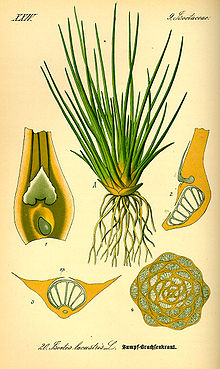Isoetales
| Isoetales | |
|---|---|
 |
|
| Scientific classification | |
| Kingdom: | Plantae |
| Division: | Lycopodiophyta |
| Class: | Isoetopsida |
| Order: |
Isoetales Bartl. |
| Families | |
Chaloneriaceae†
Isoetaceae
Pleuromeiaceae†
Nathorstianaceae†
Isoetales, formerly also written Isoëtales, is an order of plants in the class Isoetopsida. There are about 140-150 living species, all of which are classified in the genus Isoetes (quillworts), with a cosmopolitan distribution, but often scarce to rare. Living species are mostly aquatic or semi-aquatic, and are found in clear ponds and slowly moving streams. Each leaf is slender and broadens downward to a swollen base up to 5 mm wide where the leaves attach in clusters to a bulb-like, underground corm characteristic of most quillworts. This swollen base also contains male and female sporangia, protected by a thin, transparent covering (velum), which is used diagnostically to help identify quillwort species. Quillwort species are very difficult to distinguish by general appearance. The best way to identify them is by examining the megaspores under a microscope.
All quillworts and their extinct relatives are heterosporous. Some fossil species are very well known, with many stages of development and the life cycle preserved. Two of the best known are the Carboniferous Chaloneria and Cretaceous Nathorstiana.
Fossilised specimens of Isoetes beestonii have been found in rocks dating to the latest Permian. Quillworts are considered by some to be the last remnant of the fossil tree Lepidodendron with which they share some unusual features including the development of both wood and bark, a modified shoot system acting as roots, bipolar growth, and an upright stance.
...
Wikipedia
